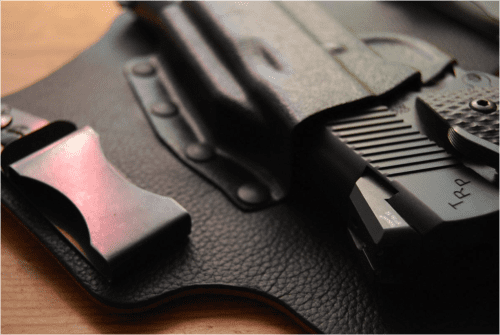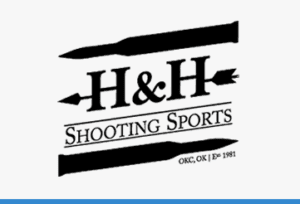 One of the first steps is to get a proper holster, like this Galco King Tuk.
One of the first steps is to get a proper holster, like this Galco King Tuk.
After completing the NSSF First Shots program, many of our participants move right on to getting their concealed carry permit. If this is your goal, there are a few things you need to know before you take on that process and begin to carry a firearm daily.
1. Get The Right Holster!
The right concealed carry holster will inspire confidence. You should be able to go about your daily business, whether your style is sedentary or active, without worry that your gun will move or fall out of your possession.
What do you look for in a goodconcealed carry holster? There are three simple things on which to focus.
First, a good holster will help you access your gun quickly, easily, and safely. It will hold your gun in a consistent position, so that, if you ever have to reach for it under stress, it will be exactly where you expect. A good holster will not move around and won’t require you to “check”the well-being or position of your gun as you move throughout your day.
Second, a good holster protects the trigger. No matter what your method of carry (waistband, ankle, purse, pocket, etc.), your holster needs to prevent stray objects or fingers from engaging the trigger. It is amazing how keys, loose coins, chairs, and other items can interfere with a trigger and potentially cause a negligent discharge.
Finally, a good holster will ensure that your gun remains under your control at all times. It will not allow your gun to work its way out of it. It will not detach itself from your belt or clothing. If you have an active lifestyle, you may even want to consider a retention holster that requires a specific physical manipulation on your part to release the gun from the holster.
If you’re unfamiliar with the wide variety of holsters available the many different ways to carry a gun, you might check out this book
2. Practice with a purpose!
If you need to use your gun for self-defense, it won’t be much like your outings to the range. Most attacks are sudden and unexpected, initiated and resolved in seconds. Your attacker will be moving. You will also (hopefully) be moving. If guns are involved, that means hitting moving targets while moving, all while under enormous stress.
Standing at the range plinking at cans and paper targets is fun and satisfying—by all means, do it! Just don’t think that kind of recreational shooting prepares you for self-defense.
If you want to start honing skills that might help you in a defensive situation, be sure to practice drawing from a holster, evaluating distance to your targets as well as what’s behind them (think a crowded street), shooting quicklyand accurately, and dealing with gun malfunctions. One good exercise many use for this last one is to have a friend load their magazines with different numbers of cartridges, so that they might have to unexpectedly change magazines. Another good exercise is to acquire some snap caps and have your friend insert them in your magazines randomly, so you can learn how to deal with your gun when it goes “click” instead of “bang.”
When you begin to incorporate these types of exercises into your practice routines, you might also create scenarios to track your progress. Try using a paper plate for a target and seeing how fast you can hit it, starting with the draw from the holster and firing five straight shots, then repeating that sequence at various distances. Track your progress and set goals for improvement in both time and accuracy. Of course, there are many professional trainers out there and shooting schools to help take you from your beginning First Shot skills and on to being a capable, accomplished, and confident shooter. They are well worth your time to research as you seek to expand your shooting skills and firearms knowledge base.
3. Defensive Shooting is Not Target Shooting!
Concealed carry for protection of self, family, and loved ones is not a sports contest. You need to change your mindset from perfect one-hole group shooting perfection to that of taking every advantage available to you to survive a deadly encounter. There’s a saying in the self-defense community: “If you’re fighting fair when protecting yourself, your tactics suck!”
If you’re thinking about carrying a gun for self-defense, the first thing to keep in mind is that, in a self-defense situation, evasion (when possible) is often the very best choice to make. No one wants to shoot someone else, so, if you can avoid doing so, you should.
Of course, evasion isn’t always possible. To prepare yourself for situations where you might have to engage with your firearm someone intending to do you harm, you have to start thinking through how such scenarios might occur, from a home invasion, a potential robbery on a quiet city street or in a parking garage, a carjacking—all those things you don’t want to think about. Think about them now, think about how you’d react while carrying a gun. Once you’ve begun to think about these things as you go about your life, start researching the many very good schools and instructors to assist you with this kind of self-defense preparation, and with the mindset and shooting skills needed to survive such an event.
4. Know The Law!
There’s not much that is more tragic than hearing about a law-abiding citizen who used a gun for self-defense, but did not know the laws concerning gun use where they lived and, so, ended up being arrested (and possibly convicted), as a result.
The nuances of self-defense laws are far too complex and varied to address here, but before you delve into researching what the laws are where you live and travel, the one thing I’d like to emphasize here is that you should understand that your concealed carry permit does not in any way, shape, or form give one person permission to harm or kill another. Beyond that, I highly recommend reading some of Massad Ayoob’s work. In my view, he’s the leading self-defense expert in the country when it comes to self defense scenarios and cases. Start with The Gun Digest Book of Concealed Carry and In The Gravest Extreme
5. Get Real Training!
If you’ve completed the NSSF First Shots program, congratulations! You’re on your way to safe and enjoyable shooting sports.
First Shots and concealed carry training classes are great starts, but your need to learn doesn’t stop there. If you have any interest in using a gun for self- or home-defense, you need professional self-defense training.
As a start, check out the hundreds of shooting videos produced by the National Shooting Sports Foundation and our industry partners. You’ll find plenty of great videos with tips and instruction. You can find those here on YouTube
. When you’re ready for hands-on instruction, you can start your search for local professionals by checking outWhereToShoot.org


